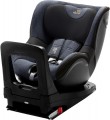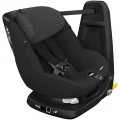Weight group
The weight of the child for which the car seat is designed.
In total, there are 5 main weight groups: 0 (0 – 10 kg; a rather rare option nowadays),
0+ (0 – 13 kg),
1 (9 – 18 kg), 2 (15 – 25 kg),
3 (22 – 36 kg). However, many car seats are produced that belong to several groups at once:
0 +/1 (0 – 18 kg),
1/2 (9 – 25 kg),
2/3 (15 – 36 kg),
0 + / 1/2 (0 – 25 kg) and even
1/2/3 (9 – 36 kg) and
0+/1/2/3 (0 – 36 kg). Such versatility affects the price, sometimes quite noticeably. On the other hand, a seat that matches several groups at once remains relevant for a child longer, and it usually costs less than two (or even more) separate products, each for a different weight category.
Note also that the weight group is directly related to age; refer to "Age range" for details.
i-Size
The car seat meets the requirements of the European safety standard
i-Size (ECE R129). Within the framework of this standard, it is assumed that child car seats are classified according to the height and age of the child, and not by weight (as was previously the case). It is also mandatory to fasten the retaining device using the Isofix system (see “Isofix fastening”). In accordance with i-Size requirements, car seats must be installed rear-facing until the child is 15 months old or reaches a height of 105 cm. All i-Size certified car seats must pass a side impact test. Chairs and cars that meet the requirements of the standard are marked i-Size, which confirms their full compatibility.
Age range
The age of the child for which the car seat is designed. Many models combine several age groups at once; such products, naturally, cost more, but remain relevant for the baby longer.
Note that this indicator is directly related to the weight group; Here are the main age ranges that are found nowadays, and the weight categories to which they correspond:
— 1 – 6 months (weight group 0); rare today.
—
1 – 12 months (weight group 0+); almost completely replaced the category "0".
—
8 – 48 months (weight group 1).
—
3 – 7 years (weight group 2).
—
6 – 12 years (weight group 3). Note that if only this weight category is indicated for the car seat, then it is a
booster: a lining without a backrest, which is placed on the standard car seat and allows the grown-up child to use "adult" seat belts. If the note "6 — 12 years" is combined with another weight category - then we have a full-fledged car seat with a backrest.
In conclusion, it is worth saying that this characteristic is not strictly defined: children of the same age may differ in development and build. So, when choosing a seat, first of all, weight should be taken into account, and then age; and if the seat corresponds to the child's height and build, there is nothing wrong with the age discrepancy.
Installation
—
Seat belt. Installation with the car seat belt. In weight groups 0, 0+ and 1, only the seat is secured in this way; the child's safety is ensured by the seat's own belts. In weight groups 2 and 3, the car belt is used to secure both the seat and the child.
—
Tor Tether. An additional harness to increase the security of fixation used in seats with Isofix and Latch systems (see below). One end of the harness is attached to the upper part of the backrest and the other end is attached to a special bracket installed in the floor of the car behind the seat or in the trunk. This reduces the likelihood of the seat being knocked over in a sudden braking or frontal impact and increases the overall safety of the small passenger.
—
Support leg. An additional attachment in the form of a support running from the bottom of the seat to the floor of the car. The purpose is similar to the Top Tether described above: it increases the safety of the seat and reduces the risk of the seat toppling when the car comes to a sudden stop. It is most often used with the Isofix system.
—
ISOFIX. The installation system for car seats in the weight category up to 18 kg is primarily found in cars from European manufacturers. The seat is secured with two locks in the rear lower part, with optional additional attachments at the top and/or b
...ottom. The design ensures foolproof installation, making it nearly impossible to install the seat incorrectly. Isofix requires the car to be equipped with suitable brackets, but even without them, these seats can usually be securely installed using the regular seat belt. However, this option may not be cost-effective, as seats with the Isofix system tend to be relatively expensive.
— LATCH. Installation system similar to Isofix. It is used mainly in American cars and, accordingly, in car seats of American manufacturers. The seat is attached at three points — two at the bottom of the seat and one at the top — so that the seat cannot be installed incorrectly. Like Isofix, seats with Latch also allow fixation with the normal car seat belt.Correct installation indicator
The presence in the design of the child restraint system of special
indicators of correct installation. They help ensure that the child car seat is installed correctly and follows all prescribed safety guidelines. Most often, such indicators are represented by special marks that change color or position when the car seat is installed correctly. Such indicators are placed on Isofix system locks, seat belts for fastening a child, etc. And some models for the youngest passengers have built-in levels or angle indicators that help set the seat in the correct position, facing the rear of the vehicle.
Adjustments
—
Backrest tilt adjustment. The backrest tilt can be adjusted. This point is different for various weight groups. In groups 0+ and 1 not the backrest, but the whole seat tilts against the fixed base, and in groups 2 and 2/3 only the backrest tilts. The possibility of adjusting the backrest tilt is important if the child is in the car for a long time – by tilting the backrest you can let the child sleep or rest.
—
Headrest height adjustment. According to safety requirements, the child's head should not be more than one third above the headrest, so it is necessary to adjust the headrest as the child grows.
—
Harness height adjustment. The ability to adjust the height of car seat harnesses — such a need arises as the child grows.
—
Backrest width adjustment. The ability to adjust the width of the backrest allows you to optimally adjust the car seat not only for constantly changing height, but also for the child's complexion.
—
Horizontal position of a backrest. The backrest of the car seat is horizontal. The horizontal position is optimal for babies under the age of six months, since it avoids unnecessary stress on the spine, therefore group 0 car seats usually have this function.
—
Removable backrest. It is possible to comp
...letely remove the backrest of the car seat. This function expands the possibilities of the seat: it can be used both for its intended purpose, with a backrest, and as a booster (for more information on boosters, refer to "Weight group 3").
— Swivel system. The seat swivels relative to a fixed base. This makes it easier to drop off and pick up the child: during these operations, the seat can be turned to face the car door, and when driving, it can be positioned in or against the direction of travel.Country of origin
The country of origin of the brand under which the product is marketed. Often indicated by the nationality of the company or the location of its headquarters. At the same time, the actual production capacity of the brand often differs from the country of origin.
The quality of products is more influenced by the organization of processes and quality control at all production stages than by geography. Therefore, biases against brands from specific regions are generally unfounded. Consideration of a brand's country of origin becomes relevant only when the goal is to actively support or avoid manufacturers from a particular state.

